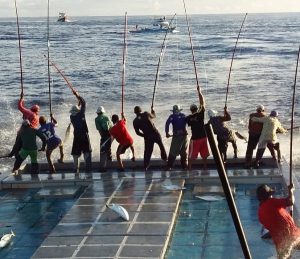Now in its second year, leaders from across Indonesia’s one-by-one tuna industry gathered in Jakarta to explore what a pole-and-line fleet for the future should look like.
The 2025 think tank, co-hosted by IPNLF and AP2HI, brought together industry leaders, government representatives, and technical experts to build consensus around the pole- and-line vessel designs of the future.
Investing in vessels to power future growth
The event was designed to tackle the operational and design challenges that could hamper future growth in Indonesia’s pole-and-line tuna fisheries.
With demand for responsibly sourced tuna at an all-time high, participants examined how innovation and collaboration can help expand the fleet while keeping one-by-one fishing fair, sustainable, and rooted in local realities.
Discussions focused on how new vessel designs can balance modern efficiency with traditional fishing methods that support livelihoods and protect marine resources, while being commercially competitive with other gears. From energy efficiency and crew safety to working conditions and fuel use, participants explored how the next generation of pole-and-line vessels can embody both innovation and practicality.
Learning from global best practice
IPNLF’s Fisheries Director, Craig Turley, shared vessel design insights from the Maldives, Japan, and South Africa, highlighting features that could be adapted for Indonesia’s fleet. Comparative analyses helped identify design elements and technologies that could enhance performance while remaining cost-effective and suitable for Indonesia’s diverse fishing regions.

Maldives one-by-one tuna fishing boats are built locally, creating further employment opportunities in this island nation.
From dialogue to design
The event marked the first step towards developing a fully costed vessel design tailored to Indonesian conditions. This design will provide a practical roadmap for modernising the fleet, improving operational viability, and positioning Indonesia as a global leader in sustainable one-by-one fisheries.
“A new vessel design would be more than a technical blueprint, it would be a pathway to ensure the pole-and-line industry continues to be resilient and sustainable for the next generation,” said Craig Turley, IPNLF’s Fisheries Director
“The pole-and-line fleet of the future must be tailored to local needs. The next generation of vessels will be designed with fishers, for fishers. They must be efficient, safe, and adapted to Indonesia’s unique conditions,” said Janti Djuari, Founder and CEO, AP2HI.
The day concluded with a roundtable discussion comparing vessel sizes, technologies, costs, and benefits, and a final discussion on vessel design. With broad participation from varied stakeholders, the think tank reinforced the importance of joint action in securing the future of Indonesia’s pole-and-line tuna sector.
As IPNLF and AP2HI continue developing the vessel design in consultation with stakeholders, the outcomes from the think tank will inform broader work on smart fishing innovation and sustainable seafood supply chains.
Stay tuned for updates as the vessel design project as we work support innovations in one-by-one fishing vessels in Indonesia.